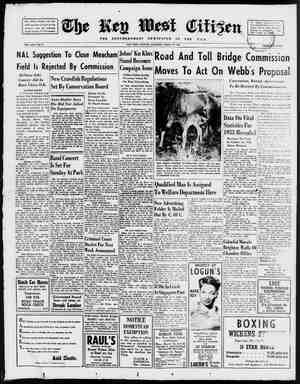The Key West Citizen Newspaper, March 13, 1954, Page 10
You have reached the hourly page view limit. Unlock higher limit to our entire archive!
Subscribers enjoy higher page view limit, downloads, and exclusive features.
Gene Otto Exhibition Other End Galveston Lane Sunday Morning Shons Brilliant T. echnique, Delicate Beauty Things Of The Sea By JIM COBB Just as Gauguin excelled in painting the South Sea Island scenes he loved best, the artistry of Key West-born Gene Otto reaches its peak in his ere of the scenes of his boyhood—preserving on canvas whatever he can of the old island atmosphere, scenes of gentle nostalgia that probably can never be recaptured by anyone but an artist of Otto's standing. Examples of his art, a series of vivid island scenes, along with several brilliant still-life paintings, may be seen in his exhibition now showing at the East Martello Gallery, Roosevelt Boulevard. Otto’s work, particularly his landscapes, show an integrity all too often absent among modern painters. The idealized approach to painting the tropics is also absent in his art—he paints the island as only a Key Wester, who has felt the warmth of the tropical sun, wandered for years among the Jebyrinth of the city's quaint, crooked streets, savored its smells and absorbed its folklore, can see it. With a keen eye for line and detail, Mr. Otto has recorded with great beauty Key West's distinctive architecture—which is all too rapidly becoming q@ thing of the past. And with his competent sense of color, and more par- ticularly the effect of the tropic sun on those colors, the artist has created an air of peace and restfulness that those of us not fortunate enough to have sampled the island life of a few years ago, may only speculate about. Perhaps much of Mr. Otto's brilliance and technical ability is due to training he received with leading artists in this country and abroad—or may- be it is because of an unusual insight into his subject matter. He has studied in the Academy of Fine Arts in Chicago, the Art Students’ League in New York, and abroad at the La Grande Chaumiere, Collorossi’s, Delecleuse and the Academie Julienne, Extensive travel throughout the continent, particularly in Italy end Spain, may have refreshed his viewpoint in painting the scenes of his youth. Mr. Otto's still-life paintings, many of which are on display at the gallery, have also gained wide acclaim. The freshness of his approach, his control ever textures, surfaces and composition, make them outstanding. As Phillip Wylie, best-selling author and a friend of Otto, says of his landscapes: ‘The cataract of light which floods Key West has challenged many painters, and then, as they painted, overwhelmed their palettes and confused their talents. “In tumults of coloration, they have generally lost, and lost altogether, that mixture of strange music and intense familiarity which they perceived and relished and endeavored to set down. The light is starkly white, the ra- diance of tropical sun so constant and so violent in the Florida Keys that it literally in time reduces every pigment to a pastel recollection of itself. And as it bathes the landscape even the most freshly-opened flower gives back from its vivid surfaces more of the sense of pure light than of any particular hue, Wylie says of Otto's siill-life paintings: "His skill at still-life... has Jong been extremely popular and highly saleable. Yet here, too, his primary Preoccupation has been with light and its interpretation, may be observed. “His arrangement of a Horse Conch shell, an odd piece of old shrimp net, a glass float, a star fish and coral have the moody lustre of the sea; his regal hen is painted not just to suggest the overlush age of Victoria, but to look like the queen, herself; he sees with an unusual eye and in an un- usual way, so that even a flower arrangement in the familiar style of the moderns has unusual presences of light upon it.” ‘All Photos by Finch. a West Indian Ruins ee maton
